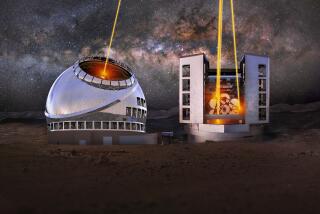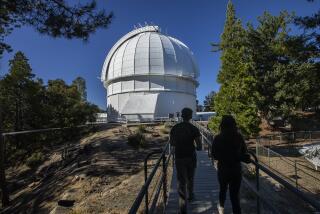Huge Telescope Mirrors Widen Window on the World : Science: Astronomers use a special furnace to mold glass. Technology will give more researchers access to the universe.
- Share via
TUCSON — The largest one-piece telescope mirror in the Western Hemisphere has been created here in a revolutionary process that promises to open many windows on the universe.
The 6.5-meter slab of glass, about the size of an average living room, is cooling slowly in a unique spinning furnace at the University of Arizona.
Astronomers are now starting to turn out huge telescope mirrors that were considered economically and technically impractical just a few years ago.
It used to take years to make a mirror many times smaller than the behemoths now being cranked out almost routinely by astronomers in the Steward Mirror Laboratory beneath the football bleachers here.
The new process has greatly reduced the tedious task of grinding the great mirrors, such as the five-meter Hale Telescope on Mt. Palomar in northern San Diego County. The Hale has dominated the field of astronomy for more than half a century, but it is much smaller than the 6.5-meter slab of curved glass that astronomers created here in just 24 hours.
Scientists have been building mirrors here with the process for several years, but until now no one was sure the technique would work on such large mirrors.
“It looks good,” said John Hill, who directed the casting of the giant mirror April 2. Astronomers have since monitored the mirror around the clock as it cools down slowly from 2,156 degrees Fahrenheit, a process that will take until at least the end of June. Then the 10-ton slab will be lifted out of the furnace and tested further, and only then will scientists be sure the process has been successful.
For the moment, however, they feel reasonably sure the new mirror will prove that the technique will be suitable for even larger mirrors, including two mirrors measuring eight meters in diameter that are to be cast sometime in the next few years for the world’s largest set of binoculars.
The 6.5-meter slab, the largest telescopic mirror built since the Hale’s mirror was cast in 1934, will have to be polished for months and finally coated with a reflective material before it can join the ranks of the world’s great telescopes. It will replace six 1.8-meter mirrors in an experimental telescope atop Arizona’s Mt. Hopkins.
The new telescope will not be as powerful as the 10-meter Keck Telescope now being built by Caltech and the University of California on Mauna Kea in Hawaii, which will use 36 hexagonal mirrors. The Keck is a bold, $90-million project designed when astronomers felt that huge single mirrors were too costly and too difficult to cast.
But the ease with which the 6.5-meter mirror was created indicates that fear was unwarranted, and it promises to bring large telescopes down in cost to within the budget of most universities, thus greatly expanding the exploration of the universe in the coming years.
“We’ve dramatically affected the market price” for large telescopes, Hill said. It costs about $9 million for a finished 6.5-meter mirror, he said.
Before the University of Arizona’s mirror lab was established, such a mirror would have cost many times that, and most experts thought it simply couldn’t be done.
In the old days, molten glass was poured into a mold and allowed to cool. Then its flat surface had to be ground to the desired shape in a process that could take years. The result was a heavy, thick, costly mirror.
The university’s spin furnace was the creation of Roger Angel, director of the mirror laboratory. Angel concluded years ago that it would be possible to greatly lower the cost of mirrors if they could be cast in a way that would reduce the need for much of the grinding required for the mirror to collect light.
Angel’s idea was to melt the glass inside in a spinning, circular furnace. Because of the rotation of the furnace, the surface of the liquid glass would be curved, just as water inside a spinning cup rises higher along the edge of the cup than in the middle. If the glass were allowed to cool while still spinning, it would harden in the desired shape, thus reducing the amount of grinding required to produce the parabolic curve the mirror needs to focus incoming light.
Angel thought that inside the furnace, the molten Pyrex-like glass would flow into a mold that would produce a single slab of glass with a smooth curved surface on the top and a honeycombed back that would reduce its weight.
In addition, mirrors created in the spin furnace would have the relatively steep curve needed to focus light close to the mirror. That would substantially reduce the size of the superstructure needed to control and house the telescope, thus bringing down the cost even more.
Although many experts initially doubted that Angel could build a spinning furnace that would operate with the precision needed to produce flawless mirrors, he has few critics today.
Hill, like many others associated with the lab, was one of Angel’s astronomy students in those early years. Angel and his students started out on a small scale, and then worked up to mirrors of 3.5 meters in diameter, which rank among the largest telescopic mirrors in the world today.
That convinced them they could build even bigger mirrors, so the furnace was enlarged and scientists at the lab set out to see if they could help bring about a revolution in astronomy.
Astronomers cannot conduct research if they cannot get access to major telescopes, and viewing time is extremely scarce. So the more telescopes that are available, the more time for studying the heavens.
That potential has not escaped workers in the lab. Researcher Dan Watson spends hour after hour monitoring television screens in the control room here, looking for signs of problems with the mirror as the temperature is slowly reduced inside the furnace.
Though it is boring work, “We do have a sense of history,” he said. “The golden age of astronomy is being brought about by new telescopes.”






